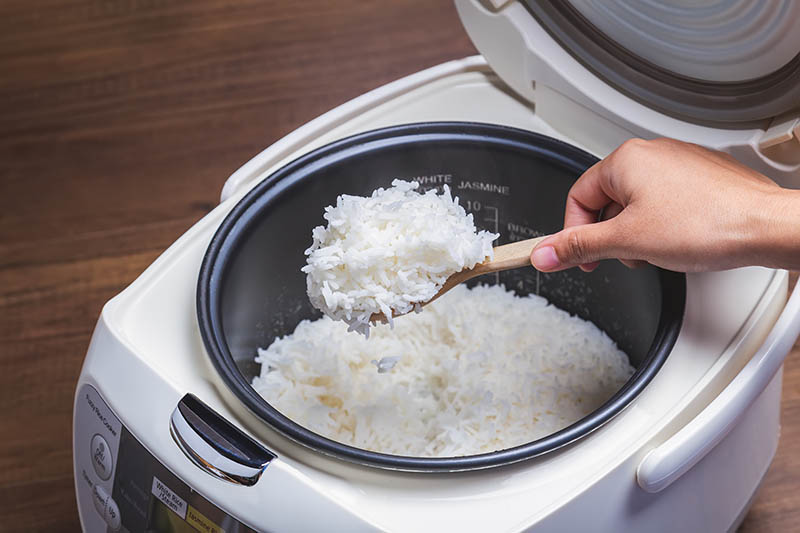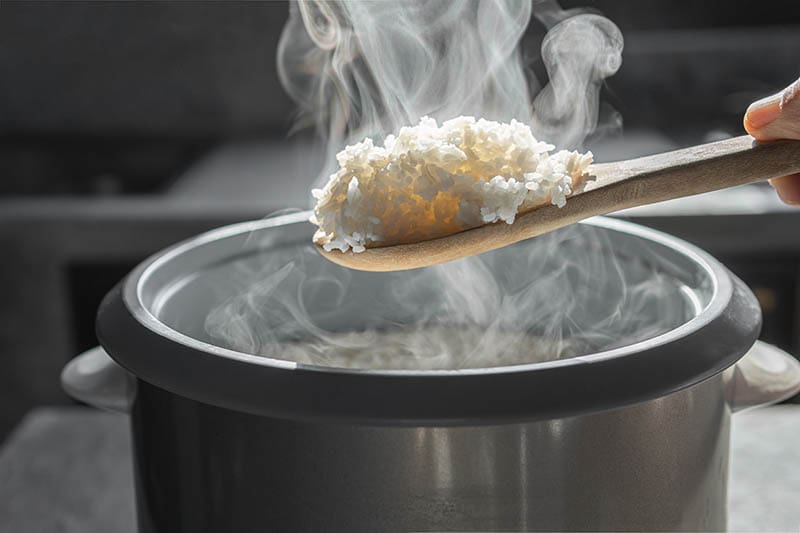Who Invented the Rice Cooker and When? History Explained
-
Pete Ortiz
- Last updated:

In Asia, rice is more than just food. For thousands of years, it’s been the symbol of women and fertility, and Japan is a great example of that. In the 40s, when the country was devastated by WWII, rice helped make it through the tough times. And that’s exactly why rice cookers are so popular over there. So, when was this appliance invented? The very-first devices were introduced in 1923.
However, it was the 1955 Toshiba device by Yoshitada Minami widely recognized as the “true” electric rice cooker. When did the company begin mass production? Are Japanese rice steamers popular in the States? Are they even worth it? Eager to learn about the history of the rice cooker? Then let’s get to it!
The Origins: The Kamado Stove
The Japanese have been cooking rice long before people discovered electricity. So, what device did they use before rice cookers were invented? The answer is kamado, a makeshift stove/oven crafted from clay or ceramic. Known in the West as the Big Green Egg, kamado was built by the Chinese more than 3,000 years ago. Later, the device was adopted by Japan, becoming a traditional cooking device there.
But, it wasn’t perfect—far from that. Cooking rice (or any other food) in a kamado took time and patience. You had to manually control the heat and the amount of water; otherwise, the rice didn’t taste good. Yet, it was the only means of getting food ready, and that’s why this device had such a strong presence in Japan for centuries.

The First-Ever Electric Rice Cooker: 1923
Mitsubishi Electronics, a core company of Mitsubishi, an international mogul, was established in 1921. Two years later, they designed and manufactured the first electric rice cooker. In the early 1930s, this cooker found its way into Japanese ships. It wasn’t a widely popular appliance, though. In fact, it didn’t even make it into Japanese households.
Post-WWII Sony’s Wooden Buckets: 1945
The Mitsubishi invention was a big step toward modern-day electric rice cookers. Still, it took more than 20 years before the next concept came around. After World War II, the Japanese economy was in ruins. Regular citizens didn’t have much cash on their hands and that’s when rice turned into a commodity. As a result, dozens of Japanese brands started to invest in the production of rice cookers.
Sony, another Japanese giant, joined the race in the early 40s and built its version of a rice steamer. Back then, it was a radio company under a different name, and their attempt was not at all successful. Essentially, the Sony cooker was a wooden bucket with aluminum electrodes. It wasn’t capable of maintaining a steady temperature to cook a delicious bowl of rice. This device was so bad that Sony didn’t even release it.
The Yoshitada Minami Breakthrough: 1955
Approximately 10 years after Sony’s failed attempt to manufacture a reliable appliance, Toshiba came through with an automatic rice cooker. Today, we know Toshiba as a powerful Japanese enterprise, but in the 50s, it wasn’t nearly as big. And, the company had Yoshitada Minami to thank for this device. It all started with Shogo Yamada, a salesman.
His mission was to sell washing machines and find out the most-desired home appliances in Japanese households. As it turned out, the vast majority of housewives wanted to have an automatic rice cooker. At that time, kamados were still very much in use. And, since most women had to cook rice 2–3 times a day, it was a lot of work. So, when the Toshiba cooker hit the market in 1955, it was an instant success.
One Family’s Struggle to Build the Ultimate Rice Cooker
Minami was a brilliant engineer, but he knew very little about the ins and outs of cooking rice. That’s why he turned to his wife Fumiko for guidance. She helped him build the device that could cook a perfect bowl of rice. For that, the appliance had to maintain a steady temperature, have enough water in the pot, and shut off at the right time. The tricky part was—the cooking time and temps differed depending on the climate.
So, Fumiko decided to cook countless bowls of rice at different times of the day and in different places. The Minami family had six children and soon, they joined their parents in this quest. The biggest challenge was to cook proper rice in cold temperatures and to keep it warm. After countless tries and errors, the solution was found: together with his son, Yoshitada built a bimetallic strip inside of a three-layer kettle.
Mass Production in Japan and Beyond: 1960s
By the 60s, the Toshiba rice cookers had become incredibly popular. Japan was slowly, but steadily recovering from the war, and people were ready to invest in various home appliances. A decade later, almost every single household in Japan had this device in the kitchen. Toshiba’s chart-topping sales inspired its rivals to come up with their own takes on the concept of an automatic rice cooker.
And soon, neighboring Asian countries were taken over by Japan’s innovation. The market was crowded with cookers of all shapes, sizes, and prices, but the original “formula” was pretty much the same. Even the most advanced appliances of our time are very similar to the 1955 Yoshitada Minami invention.
Are Japanese Rice Cookers Popular in the US?
No, they’re not nearly as big in the States as they are in Japan/Asia. It’s just that rice has never been a part of American (or Western) culture. True, many Asian-American families do have these devices in their homes. But, since there are only 20 million people in the United States that identify as Asian, rice steamers aren’t exactly topping sales charts.
With that said, back in the 1970s, many communities in the American South were quick to adopt rice cookers when they were introduced by a Chinese man from Singapore. They were looking for new ways to cook and were the first in the US to embrace Asian foods, practices, traditions, and, of course, devices. So, yes, these appliances do have a place in American cuisine today, although they’re not as widespread as in Japan.

What Is a Rice Cooker? Is It Worth It?
The biggest selling point of these appliances is that they guarantee perfectly-cooked rice. You won’t get a single burned grain. Modern-day rice cookers feature non-stick inner chambers, microprocessors that control the temperature and water intake, and user-friendly controls. And the owner doesn’t have to do much. Just fill the device with rice, add some water, and it will do the rest!
Right now, you can get a decent-quality rice steamer for $60–120, which is a fair price. Besides, when properly maintained and moderately used, it will serve for up to a decade. Premium-quality cookers last for 12–18 years. However, if you only cook rice once a month, buying such an appliance might not be the best investment.
The 5 Types of Rice Cookers: Breaking It Down
And now that we covered the history of rice cookers and their worth, here’s a quick look at the available types and their pros and cons:
1. Standard cookers
As the name suggests, these are regular cookers with non-stick inner pots. They come at an affordable price and rely on a thermostat to stop the cooking when the temperature hits a pre-set mark. The appliance doesn’t turn itself off, though: instead, it switches to the “keep warm” mode.
2. Digital cookers
Next up, we have the most popular rice steamers on the market. On top of everything from the standard devices, digital cookers come with a built-in timer, along with some useful extra features. For example, you can choose which kind of rice you’re cooking—white, brown, or sushi.
3. Induction heating cookers
The fans of properly-cooked rice often opt for induction heating cookers as they do a better job of evenly cooking the rice compared to standard and even digital cookers. This is achieved through the implementation of magnetic fields that keep the entire pot warm for a very long time.
4. Pressure cookers
If you’re looking for a flexible kitchen appliance that can cook a wide range of foods like soup, chicken, and porridge, a pressure cooker will be a great pick. It keeps heat (or, rather, steam) from escaping the pot by using pressure, thus keeping the temps a bit higher than in a “traditional” rice cooker. As a result, the cooking time is shorter. These appliances take a bit more time to master, though.
5. Fuzzy logic cookers
Last but not least, fuzzy logic cookers are the most advanced and tech-packed solution. Thanks to the built-in microprocessors/chips, they can detect the slightest temperature fluctuations. In addition, these cookers use just the right amount of water to prepare the rice. The biggest downside is the steep price tag.

Conclusion
Rice played a defining role in the survival of Japan in the 40s–60s. As for the automatic rice cooker, it helped millions of Japanese citizens enjoy perfectly cooked rice meals without putting much effort into it. The 1923 device wasn’t that great, of course, and had many flaws, just like the wooden buckets from 1945. However, Toshiba’s 1955 machine was the real deal.
To this day, most rice cookers are heavily based on that device. And, while rice steamers aren’t exactly popular in US households, in Japan (and in most Asian countries), they are a staple kitchen appliance. Besides, if you’ve ever been to an Asian restaurant in America, most likely, the rice was cooked using this “magic device”!
See also:
- Census.Gov – Population by Race 2010-2020
- Smithsonian – National Rice Cooker & Steamer
- EcoFamilyLife – How Long do Rice Cookers Last?
- HowStuffWorks – Fuzzy Logic and Rice Cookers
- What is a pressure cooker, and how do you use it?
- The Japanese Rice Cooker: A History of Trials and Errors
- AmericanHistory.Edu – National Rice Cooker & Steamer
- International.UCLA.Edu – The Art of Rice
- The Battle to Invent the Automatic Rice Cooker
- Sony’s First ‘Failure’: The 1945 Electric Rice Cooker
- Web-Japan.Org – Hi-Tech Rice Cookers
- Wikipedia – Kamado
Featured Image Credit: KT Stock photos, Shutterstock
Contents


